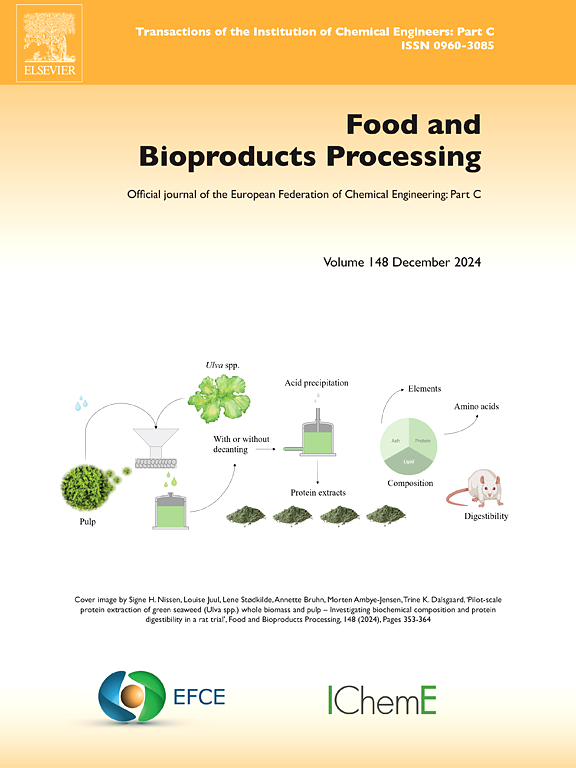Innovative electroblown nanofibrous mats incorporating sage essential oil for extending shelf life of spreadable cheese
IF 3.4
2区 农林科学
Q2 BIOTECHNOLOGY & APPLIED MICROBIOLOGY
引用次数: 0
Abstract
Cheese is a perishable item due to ongoing microbiological and biochemical changes, making proper packaging essential to prolong its shelf life while maintaining its quality. This study explores the development and application of gelatin/polyamide 6 (G-PA6) nanofibrous mats enriched with sage essential oil (SEO) for active food packaging, aimed at extending the shelf life of ultrafiltrated spreadable cheese. Using an innovative electro-blowing (EB) method, SEO’s antimicrobial and antioxidant properties were integrated into the G-PA6 matrix. The effectiveness of these nanofibers was evaluated through pH, weight loss, total viable bacteria count (TVC), and lipid oxidation (TBARS) measurements during 5 days of storage at 25 °C. The G-PA6 nanofibers enriched with SEO (G-PA6-SEO) significantly improved cheese preservation compared to control samples. Bacterial growth in G-PA6-SEO samples was reduced, with TVC at 3.51 log CFU/g on the 5th day compared to 5.38 log CFU/g in the control. Lipid oxidation was also lower in G-PA6-SEO samples, as reflected by a TBARS value of 0.59 mg MDA/kg, while the control reached 1.02 mg MDA/kg. Thus, these findings highlight the potential of SEO-enriched G-PA6 nanofibers as a promising solution for active food packaging, particularly in cheese preservation.
创新的电吹纳米纤维垫,包含鼠尾草精油,延长可涂抹奶酪的保质期
由于微生物和生物化学的不断变化,奶酪是一种易腐烂的物品,因此适当的包装对于延长其保质期同时保持其质量至关重要。本研究探讨了明胶/聚酰胺6 (G-PA6)富含鼠尾草精油(SEO)纳米纤维垫用于活性食品包装的开发与应用,旨在延长超滤涂抹奶酪的保质期。采用创新的电吹(EB)方法,将SEO的抗菌和抗氧化性能整合到G-PA6基质中。这些纳米纤维的有效性通过pH值、失重、总活菌数(TVC)和脂质氧化(TBARS)测量在25°C下储存5天来评估。与对照样品相比,富含SEO的G-PA6纳米纤维(G-PA6-SEO)显著提高了奶酪的保鲜率。g - pa6 - seo样品中的细菌生长减少,第5天的TVC为3.51 log CFU/g,而对照组为5.38 log CFU/g。G-PA6-SEO样品的脂质氧化也较低,TBARS值为0.59 mg MDA/kg,而对照组的TBARS值为1.02 mg MDA/kg。因此,这些发现强调了富含seo的G-PA6纳米纤维作为活性食品包装,特别是奶酪保鲜的有前途的解决方案的潜力。
本文章由计算机程序翻译,如有差异,请以英文原文为准。
求助全文
约1分钟内获得全文
求助全文
来源期刊

Food and Bioproducts Processing
工程技术-工程:化工
CiteScore
9.70
自引率
4.30%
发文量
115
审稿时长
24 days
期刊介绍:
Official Journal of the European Federation of Chemical Engineering:
Part C
FBP aims to be the principal international journal for publication of high quality, original papers in the branches of engineering and science dedicated to the safe processing of biological products. It is the only journal to exploit the synergy between biotechnology, bioprocessing and food engineering.
Papers showing how research results can be used in engineering design, and accounts of experimental or theoretical research work bringing new perspectives to established principles, highlighting unsolved problems or indicating directions for future research, are particularly welcome. Contributions that deal with new developments in equipment or processes and that can be given quantitative expression are encouraged. The journal is especially interested in papers that extend the boundaries of food and bioproducts processing.
The journal has a strong emphasis on the interface between engineering and food or bioproducts. Papers that are not likely to be published are those:
• Primarily concerned with food formulation
• That use experimental design techniques to obtain response surfaces but gain little insight from them
• That are empirical and ignore established mechanistic models, e.g., empirical drying curves
• That are primarily concerned about sensory evaluation and colour
• Concern the extraction, encapsulation and/or antioxidant activity of a specific biological material without providing insight that could be applied to a similar but different material,
• Containing only chemical analyses of biological materials.
 求助内容:
求助内容: 应助结果提醒方式:
应助结果提醒方式:


